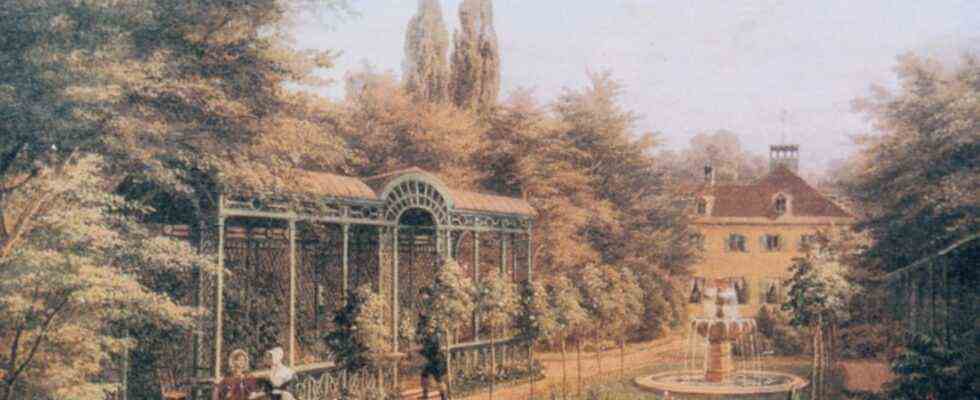Those who are strolling through the autumn-colored castle park in Ismaning these days will not only find secluded spots to rest or take a look at the brightly colored light house that has been standing in front of the castle museum for a few weeks. A stone’s throw away to the south, construction workers have carefully uncovered a roundabout over the past few weeks, which is now fenced in with bars for protection. These are the remains of a historical well that has been lying in the meadow for a long time. After an initial cleaning and the careful removal of earth and roots, a circular basin made of bricks can be seen, as well as water connections and an upright pipe, from which the more than two-meter-high fountain at this point was once fed.
In the not too distant future, the fountains are to be brought back to life, as the Ismaning municipal council has decided. The committee was now pleased with the news that the remaining parts of the well are in “surprisingly good condition”, as the town hall said. The fountain is registered as a monument in the list of monuments – and can be restored and supplemented true to the original in close cooperation with the monument protection authority.
Soothing splashing: the fountain can be clearly seen in a painting by Lorenzo Quaglio from 1847 from the Georg Schäfer Museum in Schweinfurt. Now it is to be restored according to the historical model.
(Photo: [FOTOCREDIT]
)
The office has already inspected the facility, and there is already a concept of how to revive the water features. It is true that the remains of the historical complex do not yet show how beautiful it used to be, but Ismaning’s Mayor Alexander Greulich (SPD) is certain that “the fountain will soon be back,” as he says. The restoration work is due to begin in autumn.
According to Greulich, after a not-so-easy search, a restorer was found who had been in charge of the excavation and clean-up over the past few weeks, together with an engineering office who, according to the local administration, has experience in building wells. According to the experts, the lower, remaining part of the fountain can be preserved, but must be restored. The technology itself is of course no longer in working order, it is being completely renewed. The above-ground structure with the basins from which the water falls will be reconstructed based on a historical model.
In earlier centuries, visitors to the castle park could enjoy the water feature. Today only paintings remind of the bubbling building that cast a spell over walkers. On a painting by Lorenzo Quaglio from 1847, which comes from the Georg Schäfer Museum in Schweinfurt, it is easy to see what the Mayor of Ismaning means when he speaks of the beauty that is soon to return to the palace gardens. In the middle of the green, the water fell out and into the basin, while probably noble gentlemen stretched their legs in a small round on the paths and perhaps thoughtfully listened to the calming splashing.
Amazingly well preserved: the substructure of the historic fountain in Ismaning Palace Park.
(Photo: Sabine Wejsada / oh)
In the past, the Ismaninger Schlosspark was withheld from better people, but today it is the community’s green lung and a cultural monument. In 1807, the previously baroque park was redesigned as an English garden by the garden architect Friedrich Ludwig von Sckell; With the exception of a few interventions in the 20th century, the structure of the park, the historical routing and the arrangement of the groups of trees have been preserved. In the castle park there are also special and very old trees – for example fern beech, winter linden and the primeval sequoia. This is considered a living fossil and was only rediscovered in 1941. The specimen on the meadow in front of the Kallmann Museum is more than 60 years old and 28 meters high. The splendid color of the leaves in autumn is particularly impressive. According to the municipality, the oldest walnut in Ismaning can also be found in the park. It stands on the Seebach, is more than 150 years old and 20 meters high.
The historical complex with castle, park and outbuildings is a listed building as an ensemble. The castle with the two still preserved state rooms from around 1835 serves Ismaning today as the town hall. In addition to the administrative offices, the coach building also houses the meeting rooms for the municipal council. The castle museum is housed in the former gardener’s house. The classicist orangery has been reconstructed and houses the Kallmann Museum, which is known far beyond Ismaning and will be extensively modernized in the near future. Art exhibitions take place in the palace pavilion.
Most of the main connections in the palace gardens have been renovated. In addition, paths are to be laid to the fountain system – so that the water features that have been restored can be admired up close in the future. Ismaning will spend an estimated 100,000 euros on the restoration, including the routing.

